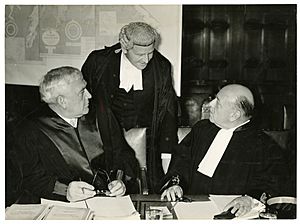Frank Soskice facts for kids
Quick facts for kids
The Lord Stow Hill
|
|
|---|---|

Frank Soskice (middle) with Sven Arntzen (left) and Maurice Bourguin in The Hague, 1951
|
|
| Lord Privy Seal | |
| In office 23 December 1965 – 6 April 1966 |
|
| Prime Minister | Harold Wilson |
| Preceded by | Frank Pakenham |
| Succeeded by | Frank Pakenham |
| Home Secretary | |
| In office 18 October 1964 – 23 December 1965 |
|
| Prime Minister | Harold Wilson |
| Preceded by | Henry Brooke |
| Succeeded by | Roy Jenkins |
| Shadow Home Secretary | |
| In office 15 February 1963 – 18 October 1964 |
|
| Leader | Harold Wilson |
| Preceded by | George Brown |
| Succeeded by | Edward Boyle |
| Attorney-General for England | |
| In office 24 April 1951 – 26 October 1951 |
|
| Prime Minister | Clement Attlee |
| Preceded by | Sir Hartley Shawcross |
| Succeeded by | Sir Lionel Heald |
| Solicitor-General for England | |
| In office 4 August 1945 – 24 April 1951 |
|
| Prime Minister | Clement Attlee |
| Preceded by | Sir Walter Monckton |
| Succeeded by | Sir Lynn Ungoed-Thomas |
| Member of Parliament for Newport |
|
| In office 6 July 1956 – 10 March 1966 |
|
| Preceded by | Peter Freeman |
| Succeeded by | Roy Hughes |
| Member of Parliament for Sheffield Neepsend |
|
| In office 5 April 1950 – 6 May 1955 |
|
| Preceded by | Harry Morris |
| Succeeded by | Constituency abolished |
| Member of Parliament for Birkenhead East |
|
| In office 5 July 1945 – 3 February 1950 |
|
| Preceded by | Henry Graham White |
| Succeeded by | Constituency abolished |
| Personal details | |
| Born |
Frank Soskice
23 July 1902 |
| Died | 1 January 1979 (aged 76) |
| Nationality | British |
| Political party | Labour |
| Spouse | Susan Isabella Cloudsley Hunter |
| Relatives |
|
| Alma mater | Balliol College, Oxford |
Frank Soskice, Baron Stow Hill (born July 23, 1902 – died January 1, 1979) was a British lawyer and politician. He was a member of the Labour Party and held several important roles in the government.
Contents
Early Life and Education
Frank Soskice's father, David Soskice, came from a family of Russian merchants. David was involved in the Russian Revolution, a big change in Russia's government. He worked for a leader named Alexander Kerensky. After the revolution, David Soskice moved to Britain and became a British citizen.
Frank's mother, Juliet Catherine Emma Hueffer, had a famous family. Her grandfather was the artist Ford Madox Brown. This means Frank was related to many well-known artists and writers!
Frank went to St Paul's School and then Balliol College, Oxford. He studied law and became a lawyer in 1926. During World War II, he served in the British Army. He worked in East Africa, Cairo, and later with a special group in London.
Frank Soskice had a son named David Soskice, who grew up to be an economist.
Political Career
After World War II, Frank Soskice became a Member of Parliament (MP) for Birkenhead East in 1945. An MP is someone elected to represent their local area in the UK Parliament.
Key Government Roles
He quickly became the Solicitor General. This is a senior legal advisor to the government. He was given a special title, a knighthood, which meant he was called "Sir Frank." He also briefly represented the UK at the United Nations General Assembly.
In 1951, he became the Attorney General, which is the chief legal advisor to the government.
Moving Constituencies
After his first area was changed, he was elected as an MP for Sheffield Neepsend in 1950. Later, in 1956, he won an election in Newport, Wales. He represented Newport until he retired from being an MP.
Home Secretary and Later Years
When the Labour Party came back into power in 1964, Frank Soskice became the Home Secretary. This is a very important job, in charge of law and order and security in the country.
While Home Secretary, he supported a law that suspended the death penalty in the UK for five years. This was a big change in British law. The death penalty for murder was later fully abolished in 1969.
In 1965, he took on a different role as Lord Privy Seal, another important government position. He retired from politics in 1966.
Becoming a Peer
When he retired, Frank Soskice was given a special honor. He became a "life peer" and was known as "Baron Stow Hill." This meant he could sit in the House of Lords, which is the second chamber of the UK Parliament. Stow Hill is the name of a steep hill in Newport, the area he represented as an MP.

